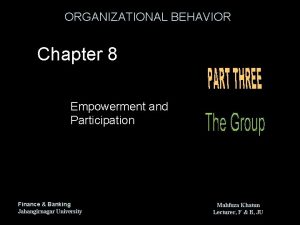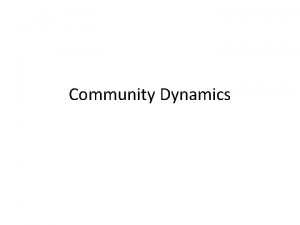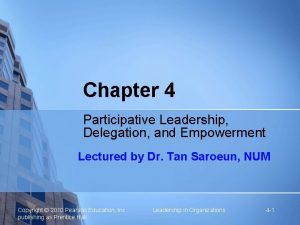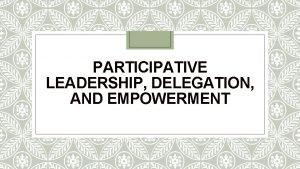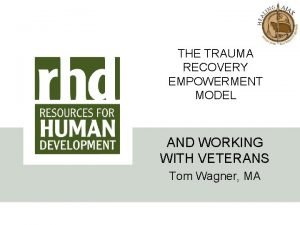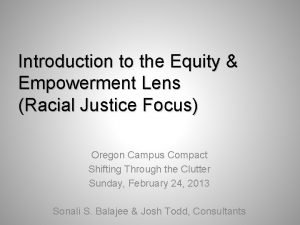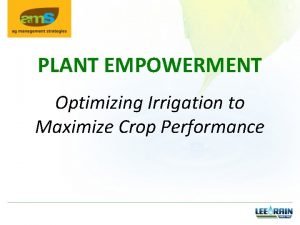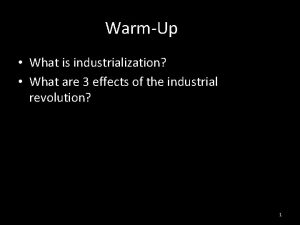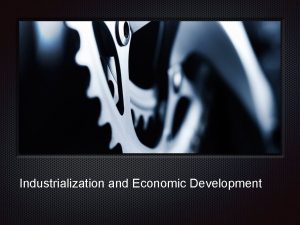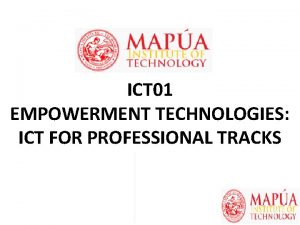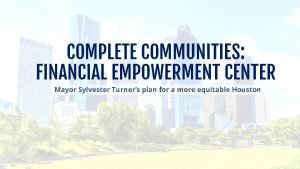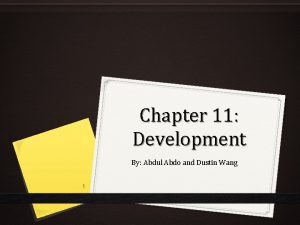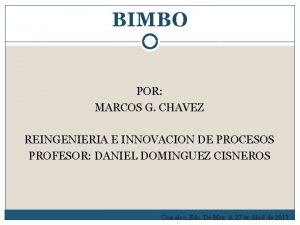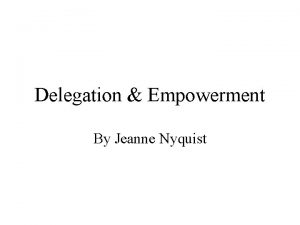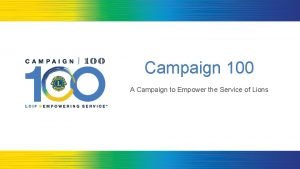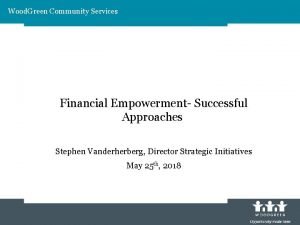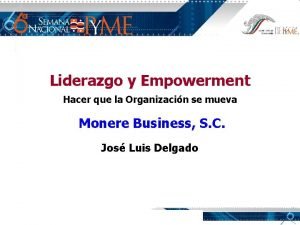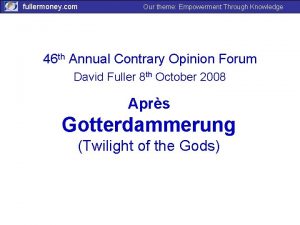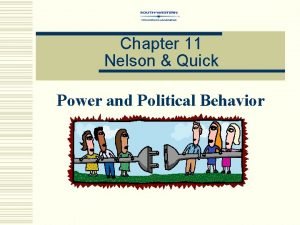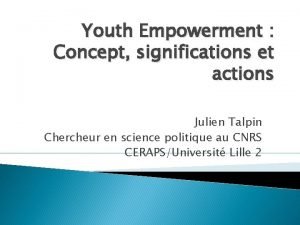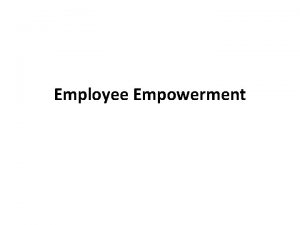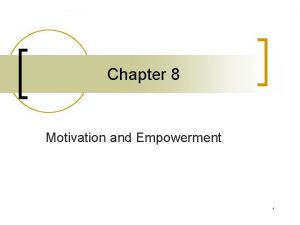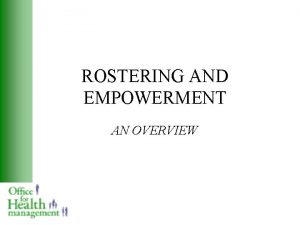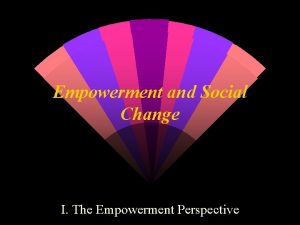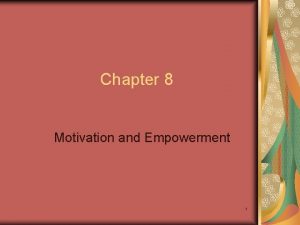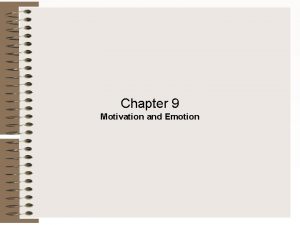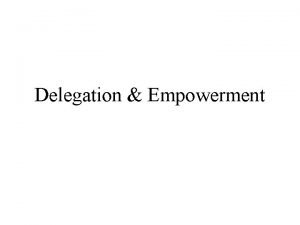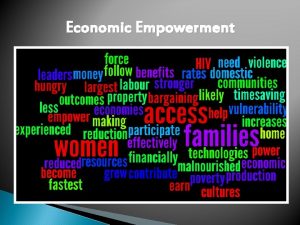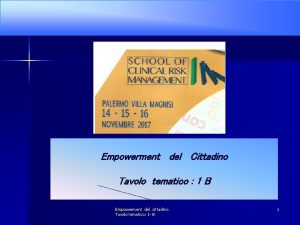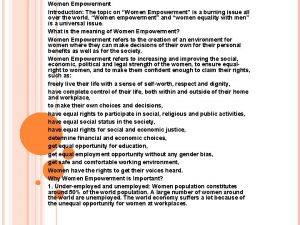Chapter 8 Motivation and Empowerment 1 Motivation The





































- Slides: 37

Chapter 8 Motivation and Empowerment 1

Motivation The forces either internal or external to a person that arouse enthusiasm and persistence to pursue a certain course of action w. The process of arousing and sustaining goaldirected behavior w. Who is responsible for this? w. Motivation is an attribution w. What is the role of money as a motivator ? 2

Two football coaches have a lot to teach screaming managers: • How does this article challenge your assumptions about motivation? • If screaming gets results, is screaming OK? Why or why not? 3

Ex. 8. 1 A Simple Model of Motivation Need Creates desire to fulfill needs (money, friendship, recognition, achievement) Behavior Results in actions to fulfill needs Rewards Satisfy needs: intrinsic or extrinsic rewards Feedback Reward informs person whether behavior was appropriate and should be used again Need: state or condition within an individual that generates movement toward some outcome or reward. 4

Types of Rewards Intrinsic Rewards ¡ Internal satisfactions a person receives in the process of performing a particular action Extrinsic Rewards ¡ Rewards given by another person, typically a supervisor, such as pay increases and promotions Systemwide Rewards ¡ Rewards that apply the same to all people within an organization or within a specific category or department 5

Ex. 8. 2 Examples of Intrinsic and Extrinsic Rewards Individual Systemwide Extrinsic Intrinsic Large merit increase Feeling of selffulfillment Insurance benefits Pride in being part of a “winning” organization Individual rewards: differ among individuals within the same organization or department 6

Ex. 8. 3 Needs of People and Motivation Methods Needs of people Conventional management Leadership Lower needs Higher needs Carrot and stick (Extrinsic) Empowerment (Intrinsic) Control people Growth and fulfillment Adequate effort Best effort 7

Ex. 8. 4 Maslow’s Hierarchy of Needs Need Hierarchy Self-actualization Needs Fulfillment on the Job Opportunities for advancement, autonomy, growth, creativity Esteem Needs Recognition, approval, high status, increased responsibilities Belongingness Needs Work groups, clients, coworkers, supervisors Safety Needs Physiological Needs Safe work, fringe benefits, job security Food, shelter, base salary Deficiency vs. growth needs 8

Herzberg’s Two-Factor Theory Hygiene Factor - work condition related to dissatisfaction caused by discomfort or pain ¡ maintenance factor ¡ contributes to employee’s feeling not dissatisfied ¡ contributes to absence of complaints Motivators - work conditions related to the satisfaction of the need for psychological growth ¡ job enrichment ¡ leads to superior performance & effort 9

Ex. 8. 5 Herzberg’s Two-Factor Theory Highly Satisfied Area of Satisfaction Motivators Achievement Recognition Responsibility Work itself Personal growth Motivators influence level of satisfaction Neither Satisfied nor Dissatisfied Area of Dissatisfaction Hygiene Factors Work conditions Pay/security Co. policies Supervisors Hygiene factors influence level of dissatisfaction Interpersonal. relationships Highly Dissatisfied 10

Motivation-Hygiene Combinations (Motivation = M, Hygiene = H) 11

Reinforcement Theory n Looks at the relationship between behavior and its consequences by changing or modifying followers’ on-the -job behavior through the appropriate use of immediate rewards or punishments Behavior is a function of its consequences 12

Behavior modification n Law of effect: positively reinforced behaviors tends to be repeated and behavior that is not reinforced tends to not be repeated. Positive consequences: results of a behavior that a person finds attractive or pleasurable Negative consequences: results of a behavior that a person finds unattractive or aversive 13

n n Positive reinforcement: the administration of a pleasant and rewarding consequence following a behavior Negative reinforcement: the withdrawal of an unpleasant consequence once a behavior is improved. Avoidance learning. Punishment: the imposition of unpleasant outcomes on an employee following undesirable behavior Extinction: the attempt to weaken a behavior by attaching no consequences to it. 14

Reinforcement & Punishment Strategies 15

Examples of Negative Reinforcement n Focused on desirable behaviors that occur more frequently: ¡ ¡ ¡ If a clerical worker feels that being ahead is a favorable condition, the worker will be motivated to work hard in order to avoid the unpleasant state of being behind. An instructor deducts 10 points from a student’s grade for each observed absence but there is no effect on a student’s grade for attendance. Example of an alarm in a child’s room. 16

Examples of Punishment n Focused on undesirable behaviors that should occur very infrequently: If you exhibit unprofessional behavior in this class, you will lose a letter grades ¡ If you are caught cheating on an exam, you could fail the course ¡ If you steal something at work, you will be terminated. ¡ 17

Acquired Needs Theory n n Mc. Clelland’s theory that proposes that certain types of needs are acquired during an individual’s lifetime Three needs most frequently studied: ¡ ¡ ¡ Need for achievement Need for affiliation Need for power 18

Mc. Clelland’s Need Theory: Need for Achievement - a manifest (easily perceived) need that concerns individuals’ issues of excellence, competition, challenging goals, persistence, and overcoming difficulties n. Set moderate goals n. Seek feedback n. Stay focused 19

Mc. Clelland’s Need Theory: Need for Power - a manifest (easily perceived) need that concerns an individual’s need to make an impact on others, influence others, change people or events, and make a difference in life n. Personal or socialized 20

Mc. Clelland’s Need Theory: Need for Affiliation - a manifest (easily perceived) need that concerns an individual’s need to establish and maintain warm, close, intimate relationships with other people What combination of needs are present in the best managers? 21

Expectancy Theory of Motivation: Key Constructs Valence - value or importance placed on a particular reward Expectancy - belief that effort leads to performance Instrumentality - belief that performance is related to rewards 22

Ex. 8. 6 Key Elements of Expectancy Theory E > P expectancy Effort Performance P > O expectancy Performance Outcomes Valence – value of outcomes (pay, recognition, other rewards) Motivation Will putting effort into the task lead to the desired performance? Will high performance lead to the desired outcomes? Are the available outcomes highly valued? 23

Theory of Inequity – the situation in which a person perceives he or she is receiving less than he or she is giving, or is giving less than he or she is receiving People are motivated when they see themselves in a position they believe is unfair. They will be motivated to either change their behavior or change their perceptions in order to restore equity 24

Carrot-and-stick controversy n n n Extrinsic rewards diminish intrinsic rewards Extrinsic rewards are temporary Extrinsic rewards assume people are driven by lower order needs Organizations are too complex for carrot-and -stick approaches Carrot-and-stick approaches destroy people’s motivation to work as a group 25

On the folly of rewarding A while hoping for B n Mangers hope for: ¡ ¡ ¡ ¡ Teamwork and collaboration Innovative thinking and risk taking Development of people skills Employee involvement and empowerment High achievement Commitment to quality Long-term growth n But they reward: ¡ ¡ ¡ ¡ The best individual performers Proven methods and not making mistakes Technical achievements and accomplishments Tight control over operations and resources Another year’s routine effort Shipping time, even with defects Quarterly earnings See three major obstacles to fixing reward systems on p. 241 26

Empowerment n n Power sharing: the delegation of power or authority to subordinates in the organization. What’s wrong with this concept? Empowerment: being enabled to make independent decisions and take effective action 27

Elements of empowerment n n n Information about company performance Knowledge and skills to contribute to company goals Power to make substantive decisions Understanding the meaning and impact of your job Rewards based on company performance 28

Other approaches n n n Employee ownership Gainsharing Pay for knowledge Pay for performance Job enrichment Goal setting? ¡ Problems with? 29

Job Characteristics Model Core job dimensions Skill variety Task identity Task significance Autonomy Feedback Critical psychological states Experienced work’s meaningfulness Experienced responsibility for work’s outcomes Knowledge of work activities’ results Employee growth, need, strength Personal and work outcomes High internal work motivation High-quality work performance High satisfaction with the work Low absenteeism and turnover 30

Examples of high and low job characteristics 31

Engagement: pp 246 -249 Bookshelf: First break all the rules n n The strength of a workplace depends upon engaged employees Leaders ¡ ¡ ¡ Recognize that you have no control Build on the talents of employees Focus people on performance 32

n Engagement is a positive, fulfilling, work-related state of mind that is characterized by vigor, dedication, and absorption. Rather than a momentary and specific state, engagement refers to a more persistent and pervasive affective-cognitive state that is not focused on any particular object, event, individual, or behavior. Vigor is characterized by high levels of energy and mental resilience while working, the willingness to invest effort in one’s work, and persistence even in the face of difficulties. Dedication refers to being strongly involved in one's work and experiencing a sense of significance, enthusiasm, inspiration, pride, and challenge. Absorption is characterized by being fully concentrated and happily engrossed in one’s work, whereby time passes quickly and one has difficulties with detaching oneself from work 33

Gallup Q-12 Engagement – cause or effect? n n n I know what is expected of me at work. I have the materials and equipment I need to do my work right. At work, I have the opportunity to do what I do best everyday. In the last seven days, I have received recognition or praise for doing good work. My supervisor, or someone at work, seems to care about me as a person. There is someone at work who encourages my development. n n n At work, my opinions seem to count. The mission or purpose of my company makes me feel my job is important My associates or fellow employees are committed to doing quality work. I have a best friend at work. In the last six months, someone at work has talked to me about my progress. This last year, I have had opportunities at work to learn and grow. #13: How satisfied are you with ____ as a place to work? 34

VIGOR When I am working, I feel mentally strong I can continue for a very long time when I am working When I work at my current job, I feel like I am bursting with energy At my job, I feel strong and vigorous When I get up in the morning, I feel like going to work DEDICATON I find my work to be full of meaning and purpose My work inspires me I am enthusiastic about my job I am proud of the work that I do I find my work challenging ABSORBTION Time flies when I am working When I am working, I forget everything else around me I feel very happy when I am working intensively I can get carried away when I am working I am immersed in my work 35

Engagement n Cause (examples: Q 12) ¡ ¡ I have a best friend at work I know what is expected of me at work My opinions seem to count My supervisor seems to care about me n Effect (examples) ¡ ¡ My work inspires me I am immersed in my work When I get up in the morning, I feel like going to work I feel very happy when I am working intensively 36

Evidence-Based Management n n What is evidence-based management? What are six substitutes that managers often use for the best evidence? What are the four things leaders can do to create a new-mindset of evidence-based management? What is the nasty side effect for leaders that practice evidence-based management? 37
 Empowerment and participation in organizational behavior
Empowerment and participation in organizational behavior Leadership delegation and empowerment
Leadership delegation and empowerment Community processes dynamics and empowerment
Community processes dynamics and empowerment Advantages of delegation
Advantages of delegation Participative leadership and empowerment
Participative leadership and empowerment Equity and empowerment lens
Equity and empowerment lens Trauma recovery and empowerment model
Trauma recovery and empowerment model Equity and empowerment lens
Equity and empowerment lens Transgender economic empowerment project
Transgender economic empowerment project Project empowerment orientation registration
Project empowerment orientation registration Plant empowerment
Plant empowerment La javier
La javier Women empowerment definition
Women empowerment definition Rust belt
Rust belt The united states is an _____. ldc mdc
The united states is an _____. ldc mdc Gender empowerment measure
Gender empowerment measure Professional track in ict
Professional track in ict Gender empowerment measure
Gender empowerment measure Gewel project in zambia pdf
Gewel project in zambia pdf False empowerment
False empowerment Houston financial empowerment center
Houston financial empowerment center Gender empowerment measure
Gender empowerment measure Empowerment bimbo
Empowerment bimbo Empowering the youth through ict
Empowering the youth through ict Grade 7 social studies empowerment
Grade 7 social studies empowerment Delegation & empowerment
Delegation & empowerment Lcif empowerment agency
Lcif empowerment agency Woodgreen financial empowerment
Woodgreen financial empowerment Liderazgo y empowerment
Liderazgo y empowerment Fullermoney
Fullermoney Kanter's symbols of power
Kanter's symbols of power Empowerment concept
Empowerment concept Apa itu ideologi negara
Apa itu ideologi negara What is a empowerment
What is a empowerment Women empowerment points
Women empowerment points Simple definition of development
Simple definition of development Presidential youth empowerment
Presidential youth empowerment Empowerment in de zorg
Empowerment in de zorg
